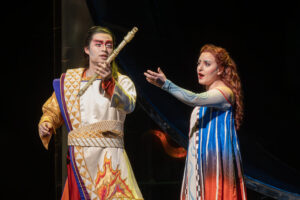
Your feelings about the new Opus Arte DVD
of Handel’s Acis and Galatea will have a lot to do with your tolerance for gentle whimsy. As a cultural consumer who tends to gravitate toward the more high-octane, Italianate drama of a Verdi overture or a Real Housewives of New Jersey hair-pull, I do my best to steer clear of pastoral operas about the lives and loves of those who tend sheep for a living, but an assignment is an assignment.
There is one point upon which all viewers of this release will agree, no matter how they feel about the music, the staging, or the price of tea in mythological Sicily. Danielle de Niese, that gorgeous young Australian-American soprano whose beauty has made her a sought-after interpreter of many great roles in the age of the opera bus ad and the HD broadcast, is a total disaster as a blonde. From her first appearance, gamboling about in front of a painting of a forest, to her final bow, the WigFail being modeled by the diva serves as an eternal and chilling reminder to us all that the wrong hairdo can completely destroy one’s beauty, even in the extraordinarily unlikely event that one is as lovely as Ms. de Niese to begin with.
There’s no getting past the wig, but all the same, we must soldier on. The events kick off with an endless act in which various characters, including the nymph Galatea (Ms. de Niese), the shepherd Acis (a sweet Charles Workman) and Acis’s friend, another shepherd named Damon, sing happily about how happy they are to be alive and, in the case of Acis and Galatea, to love one another. Throughout their singing, dancers from the Royal Opera House’s ballet company writhe and leap behind them in nude body stockings. (Their movements are graceful and seem impeccably choreographed, but I have to confess that throughout this act I was praying to the Greek gods for someone to pull out a dagger, scream out a ragged Maria Callas high note, or flip a table. My prayers were not answered.)
In Act 2, something finally happens, after the chorus has warned us at some length that something is going to happen. A potbellied, sweaty villain named Polyphemus (played by the convincingly creepy Matthew Rose) enters and sings “O ruddier than the cherry,” an aria in which he reveals his lust for Galatea. For some reason, he sings this aria while sitting on a boulder next to a taxidermied wolf, which is entirely unmoved by his wicked lust. (Speaking of wicked lust, Polyphemus’s dancing double, Eric Underwood, cuts an commanding figure in his body stocking.)
Some bucolic shenanigans occur, involving another shepherd (Ji-Min Park) who makes the most of his soothing aria “Would you gain the tender creature”; an argument; a pledge of undying love; lots more leaping around in nude body stockings; and, finally, the sudden murder of Acis by Polyphemus. Ms. de Niese stands downstage center to deliver a serviceable “Must I my Acis still bemoan” while the chorus and dancers walk in semi-circular formations behind her. The chorus reminds her of a divine loophole that will allow her to transform her lover’s dead body into a fountain (I don’t know), and de Niese gamely participates in an uncomfortably long triumphal ballet with a dancer representing Acis’s spirit.
De Niese is fine throughout; I’m not familiar enough with the role to know if she missed opportunities to unleash vocal splendor, but she certainly did a fine job of projecting “winsome” and hitting the required notes. Workman is slightly overmatched by Acis’s music, adding a little more strain than would be ideal to his portrayal. Rose’s Polyphemus is sufficiently sad and scary; given the blandness of the surrounding characterizations, his role would have benefited from a less naturalistic approach. The Orchestra of the Age of Enlightenment, conducted by Charles Christopher Hogwood, gives an excellent, inflected reading of the score; I’m not sure my enjoyment of the piece would have been impeded if it had no visual accompaniment at all.


























Comments